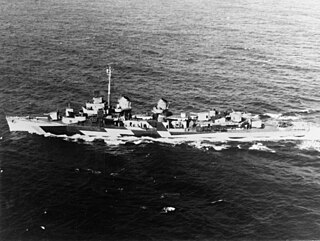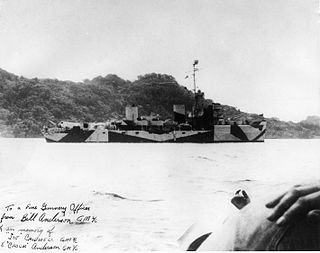
USS Chandler (DD-206/DMS-9/AG-108) was a Clemson-class destroyer in the United States Navy. She was the only ship named for William Eaton Chandler, who served as Secretary of the Navy from 1882 to 1886.

USS Newcomb (DD-586) was a Fletcher-class destroyer in the United States Navy during World War II. She was the only ship named for Commodore Frank H. Newcomb of the United States Revenue Cutter Service, Congressional Gold Medal recipient from the Spanish–American War.

USS Hogan (DD-178/DMS-6) was a Wickes-class destroyer in the United States Navy during World War II.

USS Hopkins (DD-249/DMS-13) was a Clemson-class destroyer built in 1920 and in United States Navy service between 1921-1946. The third Navy ship named in honor of Commodore of the Continental Navy Esek Hopkins, she saw extensive action in the Pacific Theatre during World War II, emerging the most decorated Clemson-class warship of that conflict.

USS Twiggs (DD-591), a Fletcher-class destroyer, was the second ship of the United States Navy to be named for Marine Major Levi Twiggs (1793–1847).

USS Wickes (DD-578), a Fletcher-class destroyer, was the second ship of the United States Navy to be named for Captain Lambert Wickes (1735–1777), who served in the Continental Navy.

The Invasion of Lingayen Gulf, 6–9 January 1945, was an Allied amphibious operation in the Philippines during World War II. In the early morning of 6 January 1945, a large Allied force commanded by Admiral Jesse B. Oldendorf began approaching the shores of Lingayen from Lingayen Gulf, on the island of Luzon. U.S. Navy and Royal Australian Navy warships began bombarding suspected Japanese positions along the coast of Lingayen from their position in Lingayen Gulf for three days. On "S-Day", 9 January, the U.S. 6th Army landed on a roughly 25 mi (40 km) beachhead at the base of the Gulf between the towns of Lingayen and San Fabian.
Destroyer minesweeper was a designation given by the United States Navy to a series of destroyers that were converted into high-speed ocean-going minesweepers for service during World War II. The hull classification symbol for this type of ship was "DMS." Forty-two ships were so converted, beginning with USS Dorsey (DD-117), converted to DMS-1 in late 1940, and ending with USS Earle (DD-635), converted to DMS-42 in mid-1945. The type is now obsolete, its function having been taken over by purpose-built ships, designated as "minesweeper (high-speed)" with the hull classification symbol MMD.

USS Shelter (AM-301) was an Admirable-class minesweeper built for the United States Navy during World War II. After service in the Pacific during World War II, Shelter was decommissioned in June 1946 and placed in reserve. In January 1964, she was transferred to South Vietnam for service in the Republic of Vietnam Navy as RVNS Chi Linh (HQ-11). She remained in South Vietnamese service until the collapse of that country in 1975. Chi Linh was one of several ships that fled from South Vietnam to the Philippines. She was then commissioned into the Philippine Navy in April 1976 as RPS Datu Tupas (PS-18), named after a chieftain of Cebu. The ship's fate is not reported in secondary sources.

USS Triumph (AM-323) was a World War II Auk-class minesweeper of the United States Navy.

USS Velocity (AM-128) was an Auk-class minesweeper acquired by the United States Navy for the dangerous task of removing mines from minefields laid in the water to prevent ships from passing. She was the second warship to bear the name.

USS Requisite (AM-109) was an Auk-class minesweeper acquired by the United States Navy for the dangerous task of removing mines from minefields laid in the water to prevent ships from passing.
USS Sage (AM-111) was an Auk-class minesweeper acquired by the United States Navy for the dangerous task of removing naval mines.
USS Tumult (AM-127) was an Auk-class minesweeper acquired by the United States Navy for the dangerous task of removing mines from minefields laid in the water to prevent ships from passing.

USS Salute (AM-294), was a U.S. Navy oceangoing minesweeper, laid down on 11 November 1942 by Winslow Marine Railway and Shipbuilding Co., Seattle, Washington; launched on 6 February 1943; sponsored by Miss Patricia Lindgren; and commissioned on 4 December 1943.

USS Turkey (AM-13) was an Lapwing-class minesweeper the U.S. Navy, thus named after the bird, not after the country which in 1917 was an enemy in the ongoing World War I. The minesweeper was acquired by for the dangerous task of removing mines from minefields laid in the water to prevent ships from passing.
USS Scout (AM-296) was an Admirable-class minesweeper built for the United States Navy during World War II; she was the third U.S. Navy ship to bear the name. She was awarded 5 battle stars for service in the Pacific during World War II. She was decommissioned in February 1947 and placed in reserve. Although she did not see service in the war zone, Scout was recommissioned in May 1951 during the Korean War and remained in commission until March 1954, when she was placed in reserve again. While she remained in reserve, Scout was reclassified as MSF-296 in February 1955 but never reactivated. In October 1962, she was sold to the Mexican Navy and renamed ARM DM-09. Although she is reported out of service, her ultimate fate is not reported in secondary sources.

USS Scrimmage (AM-297) was an Admirable-class minesweeper built for the United States Navy during World War II. She was built to clear minefields in offshore waters. She served in the Pacific Ocean and, because of her valiant efforts in combat, her crew returned home with six battle stars.
USS Scuffle (AM-298) was an Admirable-class minesweeper built for the United States Navy during World War II. She was awarded a Presidential Unit Citation and five battle stars for service in the Pacific during World War II. She was decommissioned in June 1946 and placed in reserve. While remaining in reserve, Scuffle was reclassified as MSF-298 in February 1955, but never reactivated. In October 1962, she was sold to the Mexican Navy and renamed ARM DM-05. In 1994, she was renamed ARM General Felipe Xicoténcatl (C53). She was sunk as an artificial reef and dive attraction off of Cozumel in 1999, and was stricken from the rolls of the Mexican Navy in 2000.
USS Sentry (AM-299) was an Admirable-class minesweeper built for the United States Navy during World War II. She served in the Pacific Ocean and was awarded six battle stars, a Navy Unit Commendation, and a Presidential Unit Citation. She was decommissioned and placed in reserve in 1946. In August 1962, the former Sentry was transferred to South Vietnam as RVNS Ky Hoa (HQ-09) in the Republic of Vietnam Navy. Her fate after 1962 is unreported in secondary sources.













